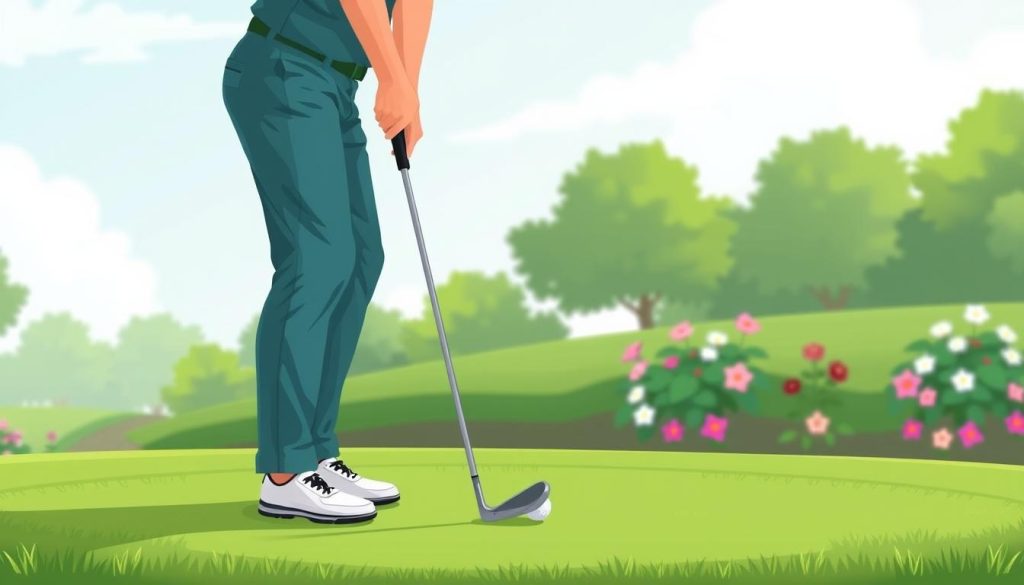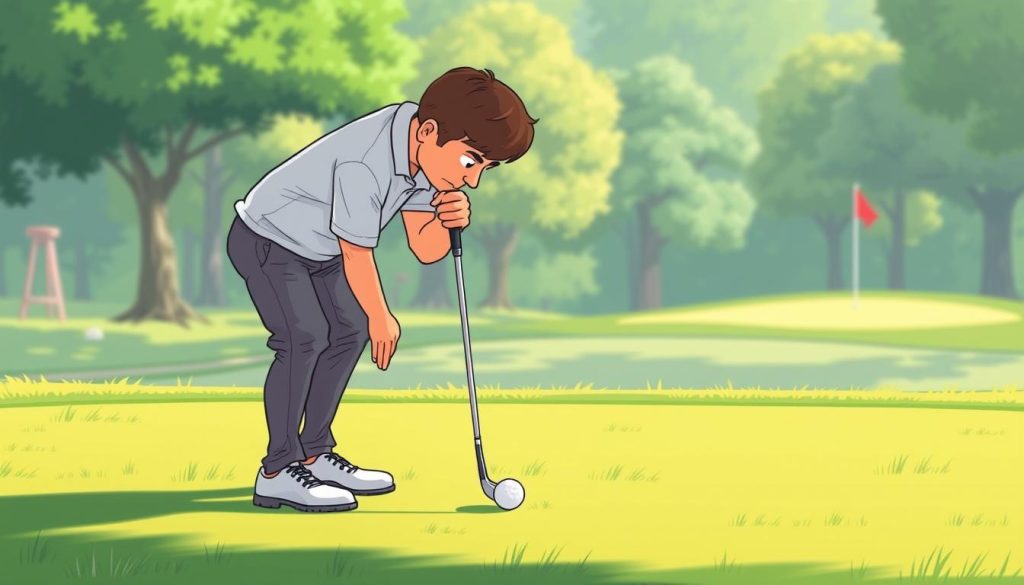Mastering your putting stroke is key to lowering your golf scores. This guide is based on over 1,000,000 golf swings. It focuses on making your putting better and more personal. You’ll learn to improve your technique, aim better, and feel more confident on the greens.
Golf putting techniques differ, but being consistent is essential. Tour pros keep their wrists still during their stroke. But amateurs often hit the ball off-target because their wrists move too much. By making your putting stroke your own, you can play better on the green.
This guide will show you how to check your stroke, find what comes naturally to you, and tailor your approach. You’ll learn about wrist motion, the debate over arc versus straight back-straight through, and the basics of impact position. By the end, you’ll know how to create a putting stroke that fits you and boosts your game.
Key Takeaways
- Consistency in putting stroke is more important than overall quality
- Wrist motion control is crucial for a reliable putting stroke
- The 2:1 tempo ratio in backswing to downswing enhances consistency
- Personalized grip and stance improve putting performance
- Analyzing and optimizing wrist motion is key to refining your putting technique
- Visualization and relaxed approach can boost putting confidence
- Regular practice with targeted drills helps develop a consistent putting stroke
Understanding the Fundamentals of Putting Mechanics
Mastering putting is all about understanding its mechanics. We’ll look at the key elements for a successful stroke. You’ll learn how to improve your game on the green.
The Role of Wrist Motion in Putting
Wrist motion is key in controlling the clubface. Some golfers aim for a “locked wrist” but a bit of wrist movement is natural. It can make your stroke smoother without losing control.
Natural Arc vs. Straight Back-Straight Through
The debate between natural arc and straight back-straight through is ongoing. But, a natural arc is always present in the stroke. It leads to more consistent putts and better performance.
| Putting Method | Pros | Cons |
|---|---|---|
| Natural Arc | Follows body’s natural motion | Requires practice to master |
| Straight Back-Straight Through | Simplifies alignment | Can feel unnatural for some golfers |
Impact Position Fundamentals
The impact position is key for direction and distance control. Most putters have four degrees of loft. This helps lift the ball and start its roll. Aim for a slight upstroke through impact for the best ball roll.
Remember, larger muscles like shoulders should drive the acceleration. This approach helps with consistency and reduces mishits.
By understanding these basics and practicing, you’ll improve your putting. You’ll see your scores on the green drop.
Putting Stroke Personalization Guide
Mastering your putting stroke is key to lowering your golf scores. A personalized approach can greatly improve your performance. Let’s look at how to analyze your stroke, find your natural tendencies, and customize your putting for better results.
Analyzing Your Current Stroke Pattern
Start by analyzing your stroke pattern. Use video or tools to watch your wrist angles and movements. Look at your flexion, extension, and rotation. This will show you where to improve your technique.
Identifying Your Natural Tendencies
Every golfer has unique putting tendencies. Some have a straight motion, while others arc. Knowing your natural style helps you develop a consistent stroke.
Customizing Your Approach
Customize your putting based on your unique needs and goals. Think about your grip, stance, and eye position over the ball. Try different techniques to find what works best for you.
| Putting Component | Customization Options | Potential Benefits |
|---|---|---|
| Grip | Conventional, Cross-handed, Claw | Improved stability and control |
| Stance | Narrow, Wide, Open, Closed | Better balance and alignment |
| Stroke Path | Straight, Slight Arc, Strong Arc | Consistency in face rotation |
| Tempo | Fast, Medium, Slow | Enhanced distance control |
Remember, personalizing your putting stroke takes time and practice. Be patient and open to making changes. With effort, you can create a stroke that feels natural and consistent.
Mastering the Perfect Tempo
Putting tempo is crucial for better golf. A steady rhythm can greatly impact your success. Let’s dive into mastering the perfect tempo to boost your putting.
The 2:1 Ratio Principle
The 2:1 ratio in putting is a game-changer. It means your backstroke should be twice as long as your forward stroke. Phil Mickelson says many amateurs have too long a backstroke, causing missed putts. By following the 2:1 ratio, you’ll keep your motion smooth and consistent.
Using Metronome Training
Metronome training helps you find the right putting tempo. Most PGA Tour pros putt at about 100 beats per minute. To improve, set your metronome between 85-110 BPM. This range helps you find your rhythm while staying professional.
Maintaining Consistent Timing
Consistency is key in putting. The Tour Tempo book recommends a stroke time of .90 seconds. Focus on using your shoulders and arms, not your wrists. This creates a smooth motion that’s easy to repeat. Remember, a steady pace increases your chances of success.
| Aspect | Recommended | Common Mistake |
|---|---|---|
| Stroke Ratio | 2:1 (back:forward) | Equal or reversed ratio |
| Tempo (BPM) | 85-110 | Too fast or slow |
| Stroke Time | .90 seconds | Inconsistent timing |
By focusing on these elements, you’ll improve your putting stroke. Regular practice will show in your performance on the green.
Grip Optimization Techniques
Mastering putting grip techniques is key to bettering your golf game. A solid grip is the base of a consistent putting stroke. It greatly affects your performance on the green. Let’s look at some effective grip optimization strategies to boost your putting skills.
Grip positioning is crucial for accuracy and control. Hold the putter in a way that feels natural and comfy. Many golfers succeed with a reverse overlap grip. This grip style brings unity to your hands, leading to better control.
Keeping grip pressure consistent is vital for a smooth stroke. Don’t grip the putter too hard, as it can cause tension in your arms and shoulders. Instead, aim for a light yet firm hold. Practice holding the putter with just enough force to prevent it from slipping.
Try different putting grip techniques to find what works for you. Some golfers like the claw grip, while others prefer a left-hand-low approach. The goal is to find a grip that feels comfortable and promotes consistent strokes. Remember, there’s no one-size-fits-all solution in golf. So, don’t be afraid to try various methods until you find your perfect match.
By focusing on grip optimization, you can greatly improve your putting performance. Studies show that golfers who regularly practice their putting technique for at least 30 minutes a day see a 25% improvement. Take the time to refine your grip, and watch your scores on the green improve.
Face Control and Path Management
Mastering putter face control and path management is key to improving your golf game. These skills can make a big difference in your putting accuracy and overall performance on the green.
Understanding Face Angles at Impact
The face angle at impact is very important. It determines the initial direction of your putt. A square face angle sends the ball straight. Open or closed faces can lead to missed putts. To improve your face control:
- Practice with alignment aids to get a feel for a square face
- Focus on maintaining a consistent face angle throughout your stroke
- Use a putting mirror to check your face angle at address and impact
Path Options for Different Putting Styles
Your putting path can vary based on your style. Some golfers prefer a straight back-straight through motion. Others use an arced path. Experiment with different paths to find what works best for you:
- Straight back-straight through: Ideal for shorter putts
- Slight arc: Suitable for most golfers and putt lengths
- Pronounced arc: Often used by players with a strong putting stroke
Correcting Common Path Issues
Many golfers struggle with path issues that affect their putting accuracy. Here are some common problems and solutions:
| Issue | Solution |
|---|---|
| Out-to-in path | Practice with alignment sticks to guide a straighter path |
| In-to-out path | Use a putting rail to promote a more consistent stroke |
| Inconsistent path | Incorporate metronome training for better tempo and path control |
Remember, improving your putting path management and face control takes time and practice. Use training aids like putting strings or mirrors to refine your technique and boost your confidence on the greens.
The Science of Takeaway Position

The putting takeaway is key to a good putt. It’s important to move smoothly from setup to backswing for consistent results. Golf Digest says knowing the swing’s parts, like the takeaway, is crucial for skill.
To get a steady takeaway, keep your putter head low and stable. Don’t lift the putter off the ground, as it can mess up ball contact. Start the backswing with a gentle shoulder rock, keeping arms and wrists still.
Using a putting mirror can help you see and fix your takeaway. Set the mirror on the ground and practice your stroke. Watch how the putter moves and its face angle at the start. This will help you make a more reliable takeaway.
The aim is to move smoothly from setup to backswing. This smooth motion helps with better putting consistency and accuracy. Regular practice will help you get the right muscle memory and boost your putting skills.
| Takeaway Component | Correct Technique | Common Mistake |
|---|---|---|
| Putter Head Movement | Low and stable | Lifting off the ground |
| Shoulder Action | Gentle rocking motion | Excessive rotation |
| Arms and Wrists | Quiet and controlled | Active manipulation |
| Transition | Smooth and connected | Jerky or disconnected |
Advanced Stroke Analysis Methods
Golf technology has changed the game, offering tools for better putting. These tools help you understand and improve your technique. You can make precise changes to your game.
Using Technology for Feedback
Modern golf tech gives you instant feedback. Sensors like those from Arccos track your every putt. They send data to apps that show you how to get better.
Video Analysis Techniques
Video analysis is a big help for improving your putting. Record your putts from different angles. Slow-motion playback shows you details you might miss in real-time.
Data-Driven Improvement Strategies
Platforms like UpGame and Decade use data to find your weak spots. They compare your stats to those of golfers at your level. This helps you focus on what needs work, leading to better scores.
- Track your putts made from different distances
- Analyze your average putt length on missed putts
- Monitor your three-putt frequency
Using these advanced methods, you’ll understand your putting better. With this knowledge and practice, you can see big improvements in your game.
Developing a Consistent Setup Routine
A consistent putting setup is key to success. By having a pre-putt routine, you’ll improve your alignment and confidence. Let’s look at how to make a routine that boosts your putting game.

Begin by keeping your routine simple. Line up the ball and stand next to it, focusing on alignment. Think about the putt’s path and keep a comfortable stance. Some golfers find an open stance helps with alignment.
Remember, being consistent is crucial. Pros make 99.43% of 3-foot putts and 80.98% of 5-foot ones.
Add these steps to your pre-putt routine:
- Read the green from behind the ball
- Choose your target line
- Address the ball with your putter face square to the target
- Take a few practice strokes to gauge the distance
- Step into your final position and make the stroke
Practice this routine often to see better putting. Spend 30 to 60 minutes weekly on drills. A good pre-putt routine clears your mind and helps you focus.
Practice Drills for Stroke Enhancement
Improving your putting skills takes practice and the right drills. Let’s look at some effective drills for path length, face control, and tempo.
Path Length Training
The “Gate Putting Drill” is great for improving your stroke path. Place two tees wider than your putter head, 6 inches in front of your ball. Practice putting through this gate to keep your putter face square and control your speed.
Face Control Exercises
The “Clock Putting Drill” is perfect for face control. Arrange 12 golf balls around the hole like a clock. Putt from each spot, focusing on how slope affects your ball’s path. This drill helps you read greens better and control your putter face.
Tempo Development Drills
For better tempo, try the “1-2-3 Putting Drill.” Practice putts from 3 feet, 10 feet, and 30 feet. This drill builds your confidence and helps you adjust to different green speeds while keeping a steady tempo.
| Drill | Focus Area | Benefit |
|---|---|---|
| Gate Putting | Path Length | Improves accuracy and square impact |
| Clock Putting | Face Control | Enhances green reading skills |
| 1-2-3 Putting | Tempo Development | Builds consistent stroke rhythm |
Remember, pros make over 99% of putts inside three feet. Spend half your practice time on these drills. This can greatly improve your short game and lower your scores from high-80s to low-80s.
Equipment Considerations for Optimal Performance
Putter fitting is key to better putting. The right putter can make your stroke more consistent and accurate. Look for a putter that fits your length, grip style, and visual preferences for comfort and effectiveness.
Brad Faxon recommends measuring from your wrist crease to the ground to find the perfect putter length. This method aligns the putter with your natural stance, improving control and feel. You can also customize your putter with adjustable weights and different designs to fit your unique style.
Sik putters have various models and alignment aids for different strokes. Their fitting process analyzes your stroke, including tempo and face rotation. They use advanced tools to find the best putter for you, making adjustments as needed.
As your putting skills grow, your stroke might change. It’s important to regularly check if your putter still fits. Investing in proper fitting and customization can help you make more putts and lower your scores.
FAQ
What is the ideal wrist motion for putting?
Is the “straight back, straight through” putting technique effective?
How can I analyze my current putting stroke?
What is the ideal tempo for putting?
How important is grip consistency in putting?
How can I improve my face control and path management in putting?
What should I focus on during the takeaway in my putting stroke?
How can technology help improve my putting stroke?
What elements should be included in a consistent setup routine?
What are some effective practice drills for improving my putting stroke?
How do I determine the right putter length for me?
Can changing my grip style improve my putting?
How does putting stroke personalization differ from general putting technique?
Source Links
- https://hackmotion.com/putting-stroke-tips/
- https://skillest.com/blog/putting-like-brad-faxon-tips-to-improve-your-putting-stroke/
- https://hackmotion.com/identifying-putting-stroke-patterns/
- http://www.hkgolfer.com/instruction/putting-fundamentals
- https://www.chadjohansen.com/wgc-putting-putting-fundamentals/
- https://www.centredegolfvaldesarbres.com/en/precision-on-the-green-the-best-golf-putting-techniques-for-golfers-of-all-levels/
- https://puttingworld.com/putt-for-par/
- https://theleftrough.com/putting-tempo/
- https://www.golfzongolf.com/blog/technology/the-art-of-putting-in-golf-a-comprehensive-guide
- https://devereuxgolf.com/blogs/live-proper-blog/putting-alignment-tips?srsltid=AfmBOooFSnPP6IoHspWXDHfZvWoMFYZQNj6BzF1vokDZiN9ZIWFBfTYo
- https://side-saddle-putting.com/how-to-putt/?srsltid=AfmBOoqnMypXIUxPJYMb2sv8Jcp50tvgA5Dmc-Cv58q6JRnSDSicVAhD
- https://hackmotion.com/best-putting-tips/
- https://www.riverhillscountryclub.com/membership/the-ultimate-guide-to-the-best-golf-training-aids-for-enhancing-accuracy-66c97.html?LayoutID=6
- https://www.trackman.com/blog/golf/the-ultimate-guide-to-understanding-trackman
- https://skillest.com/blog/mastering-the-follow-through-in-your-golf-swing/
- https://clubhouseofspearfish.com/golf-swing-mastery-tips/
- https://www.drawmorecircles.com/post/5-best-strokes-gained-apps-golfers
- https://www.ncbi.nlm.nih.gov/pmc/articles/PMC10719856/
- https://hackmotion.com/how-to-become-consistent-in-golf/
- https://www.bobbywaliagolf.com/8-putting-tips-to-improve-accuracy/
- https://golf.com/instruction/putting/calibration-putting-drill-3-feet-jamie-mulligan/
- https://sundaygolf.com/blogs/news/golf-putting-drills?srsltid=AfmBOorLewOMksp_34stluGrg9U1C01ije2ipe3y1WU0s04UTk7N1K8r
- https://putterhead.com/blogs/news/golf-gear-galore-a-comprehensive-guide-to-equipment-selection-and-maintenance?srsltid=AfmBOoo9y4EnD16H1iwewaxPY1nm-TwlwNtblxcrmbnCvSkTl0Y5fCV5
- https://www.fixit-golf.com/post/the-ultimate-guide-to-sik-putter-fitting


